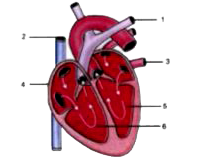In frog, deoxygenated blood is received by
Sinus venosus
Left atrium
Ventricle
Truncus arteriosus
The correct Answer is:A
To answer the question "In frog, deoxygenated blood is received by," we can follow these steps:
1. Understanding the Frog's Circulatory System:
- Frogs have a unique circulatory system that includes a heart with three chambers: two atria and one ventricle.
2. Identifying the Components of the Heart:
- The heart consists of:
- Sinus Venosus: A chamber that collects deoxygenated blood from the body.
- Left Atrium: Receives oxygenated blood from the lungs.
- Ventricle: A single chamber that mixes deoxygenated and oxygenated blood before it is pumped out.
- Truncus Arteriosus: The vessel that carries blood away from the heart to the body.
3. Tracing the Path of Deoxygenated Blood:
- Deoxygenated blood returns from the body through the systemic veins and enters the Sinus Venosus first.
4. Conclusion:
- Therefore, the correct answer to the question is that deoxygenated blood is received by the Sinus Venosus.
Final Answer:
In frog, deoxygenated blood is received by the Sinus Venosus.
---
- Frogs have a unique circulatory system that includes a heart with three chambers: two atria and one ventricle.
- The heart consists of:
- Sinus Venosus: A chamber that collects deoxygenated blood from the body.
- Left Atrium: Receives oxygenated blood from the lungs.
- Ventricle: A single chamber that mixes deoxygenated and oxygenated blood before it is pumped out.
- Truncus Arteriosus: The vessel that carries blood away from the heart to the body.
- Deoxygenated blood returns from the body through the systemic veins and enters the Sinus Venosus first.
- Therefore, the correct answer to the question is that deoxygenated blood is received by the Sinus Venosus.
In frog, deoxygenated blood is received by the Sinus Venosus.
Topper's Solved these Questions
- BOOK - AAKASH INSTITUTE ENGLISHCHAPTER - STRUCTURAL ORGANISATION IN ANIMALS (CONTD . . .) (ANIMAL MORPHOLOGY)EXERCISE - Assignment (Section-B)75videos
STRUCTURAL ORGANISATION IN ANIMALS (CONTD . . .) (ANIMAL MORPHOLOGY)
- BOOK - AAKASH INSTITUTE ENGLISHCHAPTER - STRUCTURAL ORGANISATION IN ANIMALS (CONTD . . .) (ANIMAL MORPHOLOGY)EXERCISE - Assignment (Section-C)28videos
STRUCTURAL ORGANISATION IN ANIMALS (CONTD . . .) (ANIMAL MORPHOLOGY)
- BOOK - AAKASH INSTITUTE ENGLISHCHAPTER - STRUCTURAL ORGANISATION IN ANIMALS (CONTD . . .) (ANIMAL MORPHOLOGY)EXERCISE - Exercise30videos
STRUCTURAL ORGANISATION IN ANIMALS (CONTD . . .) (ANIMAL MORPHOLOGY)
- BOOK - AAKASH INSTITUTE ENGLISHCHAPTER - STRUCTURAL ORGANISATION IN ANIMALS ( ANIMAL TISSUES ) EXERCISE - Assignment (Section-D)20videos
STRUCTURAL ORGANISATION IN ANIMALS ( ANIMAL TISSUES )
- BOOK - AAKASH INSTITUTE ENGLISHCHAPTER - TEST 1EXERCISE - Examplle19videos
TEST 1
Similar Questions
Knowledge Check
- Question 1 - Select One
Read the following statements carefully
(i) In fishes, the heart pumps out deoxygenated blood which is oxygenated by the gills and supplied to the body parts from where deoxygenated blood is returned to the heart.
(ii) The openings of the right and the left ventricle into pulmonary artery and aorta respectively are provided with the mitral valves.
(iii) The nodal musculature has the ability to generate action potential without any external stimuli, i,e., it is autoexcitable.
(iv) The T-wave of ECG represents depolarisation of the ventricles.
Which of the above four statements are incorrect?A(i) and (ii)B(ii) and (iv)C(i) and (ii)D(iii) and (iv)
The partial pressure of O2 in atmospheric air, alveoli, deoxygenated blood, oxygenated blood and tissues respectively (in mm Hg) is
View SolutionWhat is the pO2 in the oxygenated blood and deoxygenated blood?
View SolutionIn humans , deoxygenated blood flows from:
View SolutionEvery 100 mL of deoxygenated blood delivers approximately
View SolutionWhy is it necessary to separate oxygenated and deoxygenated blood in mammals and birds?
View SolutionThe only exception in the human body where an artery carry deoxygenated blood is the
View SolutionGiven alongside is a diagram of the human heart showing its internal structure. Label the parts marked 1 to 6, and answer the following questions.

Which chamber of the heart receives deoxygenated blood from the body?View Solution

